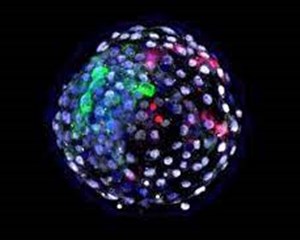Experimental biology
實驗生物學
Fantastic beasts and how to make them
神獸以及如何創造神獸
Researchers have created embryos from a mix of monkey cells and human ones
研究人員創造出了半人半猴的胚胎
The ancient greeks were good at inventing fantastical animals. The chimera, for instance, was "a thing of immortal make, not human, lion-fronted and snake behind, a goat in the middle". It was eventually slain by Bellerophon, with help from his flying horse.
古希臘人擅長想象神奇動物。比如,客邁拉是“一種不朽的創造物,非人類,獅頭,蛇尾,羊身”。柏勒洛豐在他的飛馬的助力下,最終將其殺死。
Not all chimeras are mythological. To biologists, the term describes organisms whose bodies consist of cells from two distinct lineages. In twin pregnancies, for example, one twin can occasionally absorb the other. The resulting individual is built from cells with separate genomes. A 2019 forensic-science conference discussed the case of a man who had received a bone-marrow transplant. Since bone marrow produces blood cells, subsequent DNA tests on the man's blood matched his donor's genome, not his own. (More unexpectedly, the donor's DNA also turned out to be present in swabs taken from the man's cheeks, and in his semen.)
并非所有客邁拉都是神化虛構。在生物學家口中,這個詞意指那些身體由來自兩個不同譜系的細胞組成的生物。例如,在雙胎妊娠中,一個胎兒偶爾會把另一個“吸收”掉,最后出生的個體是由具有不同基因組的細胞組成的。2019年,一次法醫科學會議討論了一名男性接受骨髓移植的案例。由于骨髓產生血細胞,后續對這名男子的血液DNA檢測顯示它匹配的是供體的基因組,而不是他自身的基因組。(更出人意料的是,在他的口腔拭子和精液中也發現了供體的DNA。)

For several decades scientists have been experimenting with cross-species chimeras, organisms which, as in the Greek myths, are composites of different animals. They have created mouse-rats, sheep-goats and chicken-quails. Now, in a paper published in Cell, Tao Tan, a biologist at Kunming University of Science and Technology, and a team of American, Chinese and Spanish researchers, report efforts to extend the principle to humans. They have managed to create embryos that are part-monkey and part-human.
幾十年來,科學家一直在試驗創造跨物種嵌合體——和希臘神話中的神獸一樣,它是不同動物的復合體。他們創造了小鼠-大鼠、綿羊-山羊以及雞-鵪鶉嵌合體。現在,昆明理工大學的生物學家譚韜和一個由美國、中國和西班牙的研究人員組成的團隊在《細胞》期刊上發表的研究嘗試將這種原理擴展到人類。他們成功地創造出了部分猴子、部分人類的胚胎。
The work builds on earlier endeavours by many of the same researchers. In 2017 Juan Carlos Izpisúa Belmonte, a biologist at the Salk Institute in San Diego, announced the creation of chimeric humanpig embryos. But quite how successful those efforts were is uncertain. Only about one cell in 100,000 in the embryos were human, and it was unclear whether they contributed to the organism's growth. This time things are different. The human cells seem happy to co-operate, at least some of the time, with the monkey ones.
這項研究建基于許多團隊成員此前的探索之上。2017年,圣地亞哥的索爾克研究所的生物學家胡安卡洛斯伊茲皮蘇亞貝爾蒙特宣布創造出了人-豬嵌合胚胎。但這些研究到底有多成功仍不確定。這些胚胎中每十萬個細胞里大約有一個人類細胞,而且也不清楚它們是否對生物體的生長有貢獻。這次情況有所不同。至少在某些時候,人類細胞似乎樂于和猴子細胞合作。
譯文由可可原創,僅供學習交流使用,未經許可請勿轉載。











